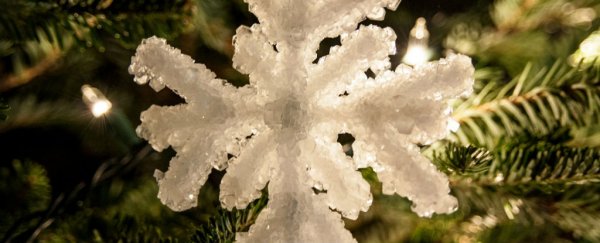Whether you're snowed in or it's too hot to go outside, the holidays are a great time to attempt some science at home. So we've found a few activities which are also, for the most part, rather practical.
Read on to find out how to make your live Christmas tree last longer, how to make a flamethrower out of an orange peal, and how to take advantage of some basic chemistry to make snowflake ornaments for your home.
Keep your Christmas tree alive with hairspray
Christmas trees are lovely and stuff, but they tend to go brown and drop their needles on you and your carpet, often before the festive season is over. So back in 2014, a bunch of year 7 schoolgirls in Sydney, Australia teamed up with University of New South Wales (UNSW) plant ecology professors to come up with a solution - and learn some great science.
They performed an experiment using branches from Monterey pine under various conditions - including keeping them in beer or an energy drink instead of tap water. One condition also involved spraying the branches with hairspray, and to everyone's surprise, that turned out to be a winning combination. The hairsprayed branches kept their luscious green needles for longer, and even started sprouting new growths. The scientists speculated that hairspray might be blocking the pores in the leaves, keeping moisture in.
So once you've hauled your Christmas tree home, try giving it a healthy dose of hairspray to make the festive spirit last longer.
Combust an orange peel
You probably know that by emptying half an orange and filling it with vegetable oil, you can create simple, yet festive candles without the need for wax moulds or anything elaborate. But you can also use an orange peel to create a flaming spectacle at the dinner table, so long as you're really, really careful. Citrus peels contain an organic compound called limonene - this volatile oil is not only responsible for the citrus scent, but is also incredibly flammable.
To test this, all you need is a candle, and a thick piece of orange peel. Hold the peel next to a lit candle, and squeeze it so that some of the aromatic compounds land in the flame. This should produce a nice flamethrower effect, so please make sure there's nothing nearby that could catch fire, too. We bear no responsibility…
Grow borax crystal snowflakes
For a slightly more elaborate crafting session, you can grow your own crystals on snowflake shapes to create icy-looking ornaments that won't melt. For this you'll need to acquire some household borax - the chemical is called sodium borate, a white powder that easily dissolves in water. You'll also need some pipe cleaners, string, a pencil, and a wide-mouth jar.
Simply fold the pipe cleaners into snowflakes and tie them to a string. Fill the jar with boiling water and add three tablespoons of borax per cup of water, then stir to dissolve. Tie the snowflake to a pencil and hang into the borax solution, using the pencil as a prop so you can get the snowflake out later. Don't let the snowflake touch the sides or bottom of the jar - it needs to sit freely in the liquid in order for crystals to form.
Let the jar sit overnight, and admire your handiwork in the morning. The reason this works is because more borax can be dissolved in hot water than in cold, thus reaching saturation. As the water cools, the extra borax cannot be contained by the water, so instead of staying dissolved, it forms back into crystals.
Bonus: If you're into natural history, why not use a gingerbread baking session to nerd out about the anatomy of your favourite animals?
Bonus two: Create a snowflake in a plastic bottle, if you have access to some dry ice and time, and patience.
